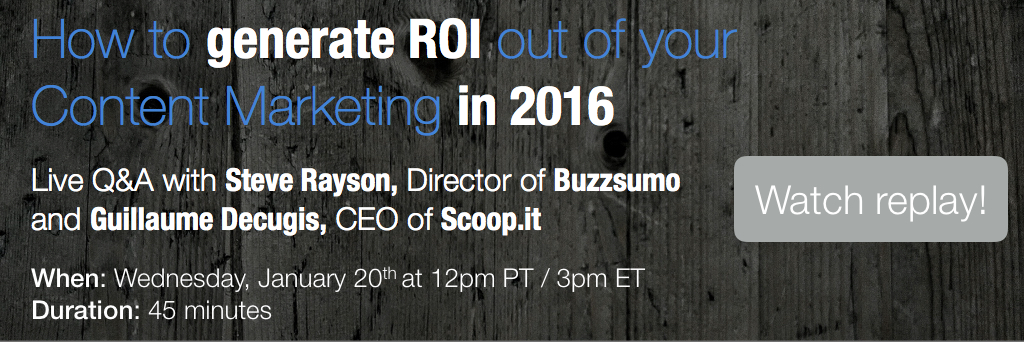We just had our most-attended webinar ever, focusing with my friend Steve from Buzzsumo on a hot topic for content marketers as we start the year: how to generate ROI from your content marketing in 2016? So for those of you who couldn’t attend, here’s a summary of our conversations and the best practices we presented as well as answers to the many questions from the audience we didn’t have time to cover. You can also view the replay of the webinar.
Fantastic webinar just now from @gdecugis and @buzz sumo on ROI for content marketing. So helpful. Thanks.
— Patrick Olszowski (@civility1) January 20, 2016
Content is the fuel of marketing; but it’s a struggle for most marketers
Content has become the fuel of marketing. It helps generate SEO and traffic but also build brand awareness, generate leads, nurture prospects and engage existing customers. But yet, a lot of marketers struggle with content. We’ve been observing that a lot and that’s actually the whole reason we started Scoop.it (and later built Scoop.it Content Director on top of our free curation service). But we’re not the only ones to see that:
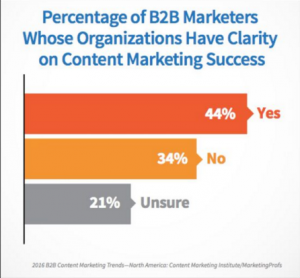
- The Content Marketing Institute published a couple of months ago their yearly benchmark in which an impressive 56% of marketers admit either failing or lacking clarity on whether they’re successful or not.
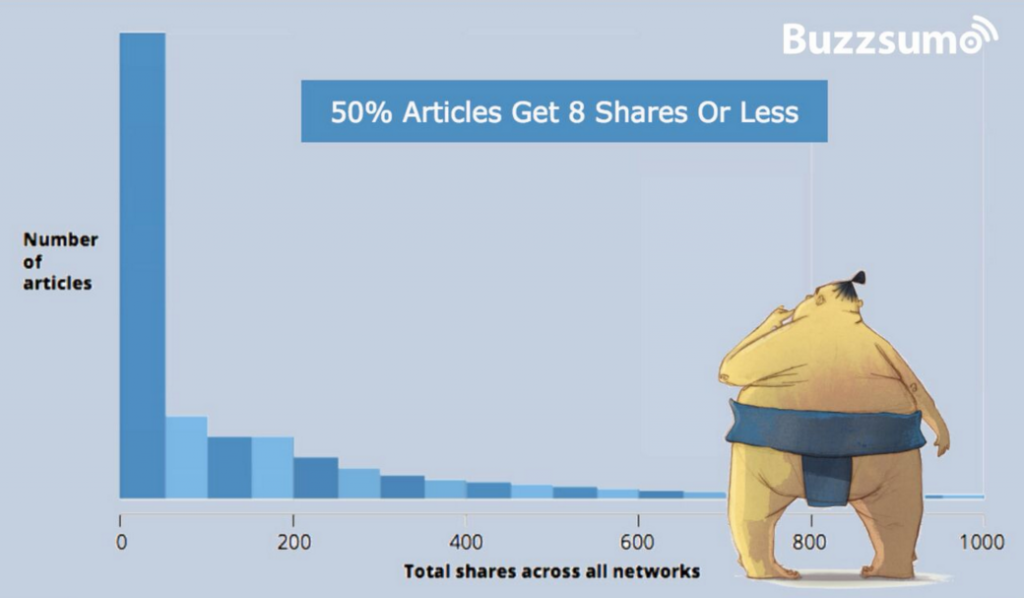
- Buzzsumo published awesome data showing that 50% of blog articles get less than 8 shares! As Steve pointed out, this is not the typical normal 80/20 distribution you would expect: it’s a lot steeper as it declines. Here again, another 50% of marketers seem to be failing with content.
Content being costly and time-consuming to produce, you might legitimately ask where the ROI is in content marketing.
Optimizing the Content Marketing lifecycle to generate ROI
The return of a content strategy should be clear: forget vanity metrics, content should bring you brand awareness and/or – even more importantly if you’re in B2B – leads and revenue. As we mentioned last year in our content marketing handbook for SMBs, it’s ROI or… RIP when your business depends on the demand your marketing generates.
Unlike traditional marketing activities which tend to run in campaigns, content marketing is an ongoing cycle. You can’t invest in a one-off campaign with content and expect to have results. You can’t for instance publish 2 or 3 blog posts and then forget about your blog. So that’s why successful content marketers win by optimizing the various steps of this content marketing lifecycle:
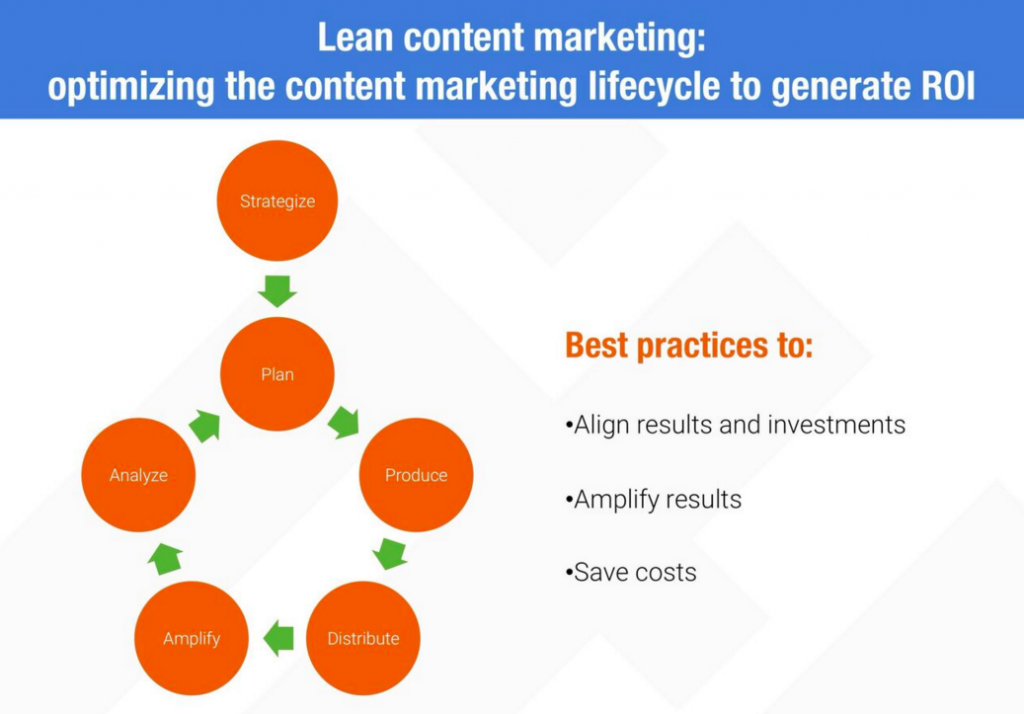
Identifying and validating best practices to do just that is what we’ve called lean content marketing and what we’ve detailed below.
1. Strategize: what content should you create? where and how should you publish it?
Obviously, this can be a very blocking question: if you don’t know what to create, you won’t go far. But sometimes we get carried away as it’s easy to create content for content’s sake and forget what should drive us: we aim at creating “viral” content or try to be funny or recycle cheap tricks we’ve seen BuzzFeed or the HuffPost be successful with. I plead guilty as we’ve done it on this blog and on our social channels.
But why does content marketing work?
It works because in this digital age, buyers can and will educate themselves online and on their own before making a buying decision. While in the old days, prospects started by calling vendors to describe their problems and ask to be presented potential solutions, the buyer’s journey is now mostly done digitally. Customers have problems and are looking to solve them: they ask their questions to Google or social media. Therefore, smart marketers that publish content that answers these questions will (1) be discovered (2) bring value and trust and (3) be considered.
So as my friend Barry Feldman summarizes it, a great way to think about your content strategy is to:
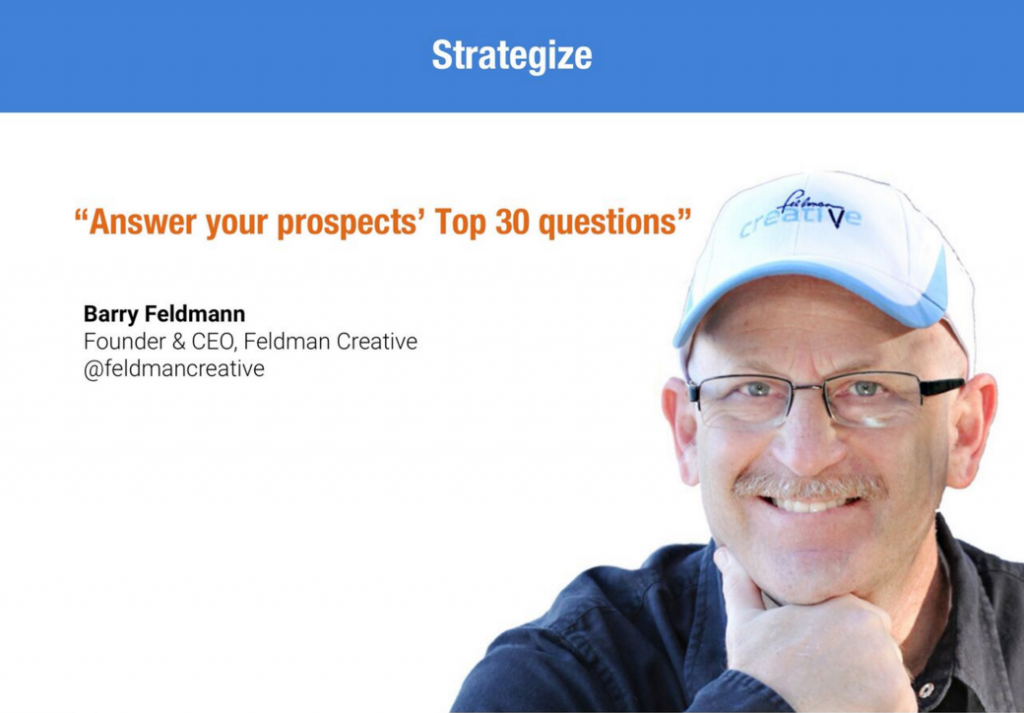
These are not just questions for when your potential prospects are ready to buy. Find out from customer interviews or from your sales team what questions they have at each stage of your funnel: awareness, consideration and decision.
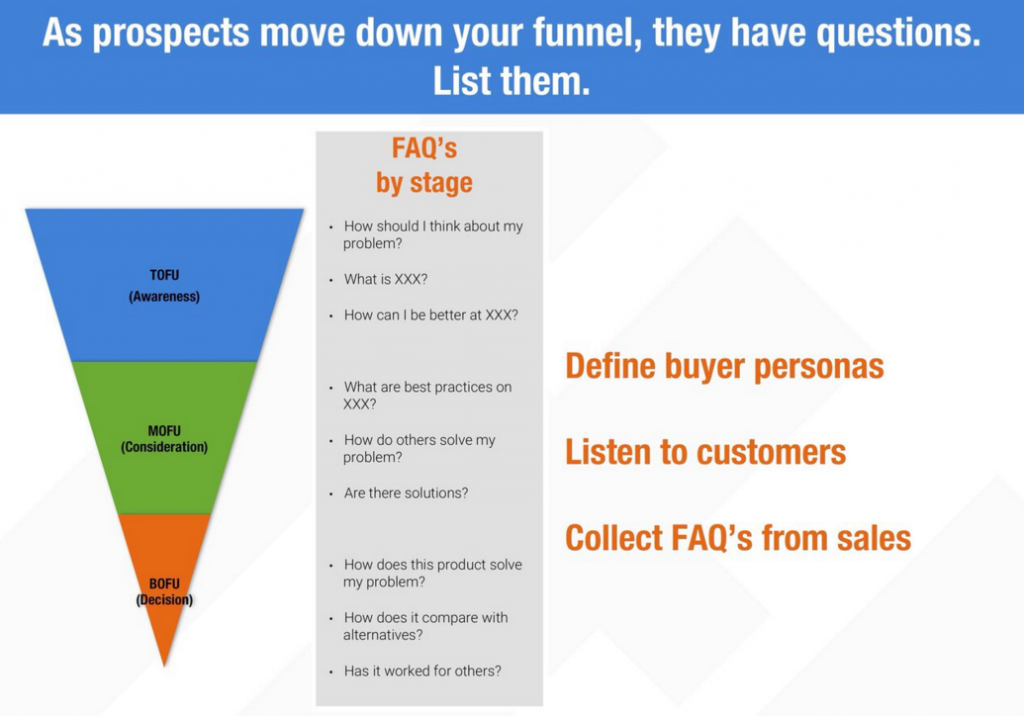
”Are you in a position to be the best answer to this question?”
Steve Rayson – Buzzsumo
Once you’ve done this, you’ll have your content marketers’ mission objectives: create answers to each of these questions. And as Steve pointed out, don’t just create any answer: create the best answer to these questions – best being for your particular target audience. This means this can work for whatever niche you’re in and regardless of your audience’s size. But for those people you target, your answer needs to be really good.
This brings up another important consideration for your strategy: absolute traffic is not likely to be your main KPI. Sure, it’s important and you’ll need some traffic. But if you’re selling to Fortune 500 companies’ CFOs, you will never get a million views on your content. Nor should you try to. Back to our ROI definition, conversions should be what you shoot for: attracting targeted leads that you can nurture down your funnel and finally convert to customers. So what this means is that you should plan relevant call to actions for each stage of your funnel: assuming your target audience finds your content great, what will you ask them to do next? Define call-to-actions (CTA’s) for each stage of your funnel that nicely aligns with your buyer persona’s mindset at this stage and the content you plan to bring them.
2. How to plan to publish good content consistently
So how much content do you need?
We had an interesting debate with Steve on this as he mentioned the Buzzsumo team had just been going through this very question and concluded they would focus on less really really good content.
Given the shape of the sharing distribution slide Steve showed, this would make sense. However, here’s another data point that kind of contradicts this from HubSpot who produces a great benchmark on blogging every year:

This correlates with our own observations across the Scoop.it platform: when we analyzed how the most successful of our 2M+ users were gaining traffic, we realized that those who focused on quality had 4x more traffic but also that those who focused on quantity also had 4x more traffic than the average. Interestingly, those who managed to do both had 10x more traffic.
And then again, you just don’t become awesome at content overnight: only practice makes perfect so if you wait to excel at content to hit the publish button, you might never do…
This gives an interesting perspective to this debate on quality vs quantity that I would summarize as follows:
- You ideally would want to publish lots of awesome content.
- Chances are you can’t.
- Crap content won’t work so scaling up through lower quality is not an option.
- As Marcus Sheridan puts it: “some “just okay” content that is published will crush “awesome content” that never gets published.”
- Therefore, set up a threshold for “good enough”.
- Create as much as you can that meets these criteria.
- Leverage the following best practices to scale while maintaining your quality standards.
From “quantity or quality?”, the question becomes:
”How do you scale your content volume while maintaining your quality level?”
3. How to produce good content at scale
Commit to be consistent: use a content calendar
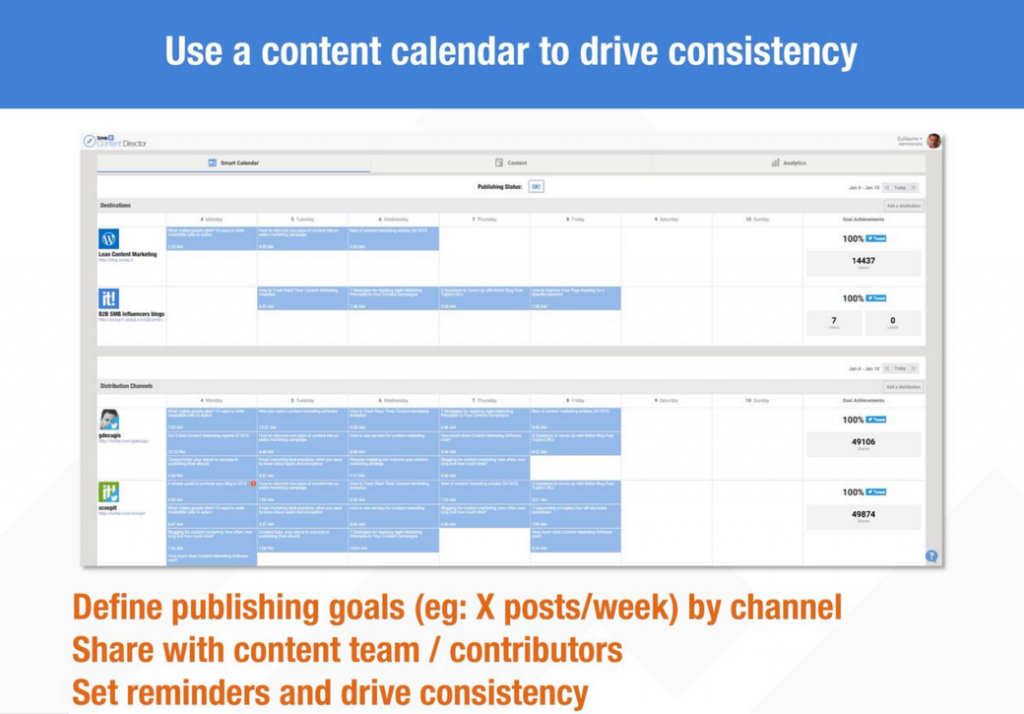
A first, seemingly obvious but critical element is to commit to being consistent. To do that, you should use an editorial calendar: at the very least a Google spreadsheet as the Buzzsumo team does or, to save time and be more efficient, a dedicated software calendar such as the one included in our own Scoop.it Content Director.
Research
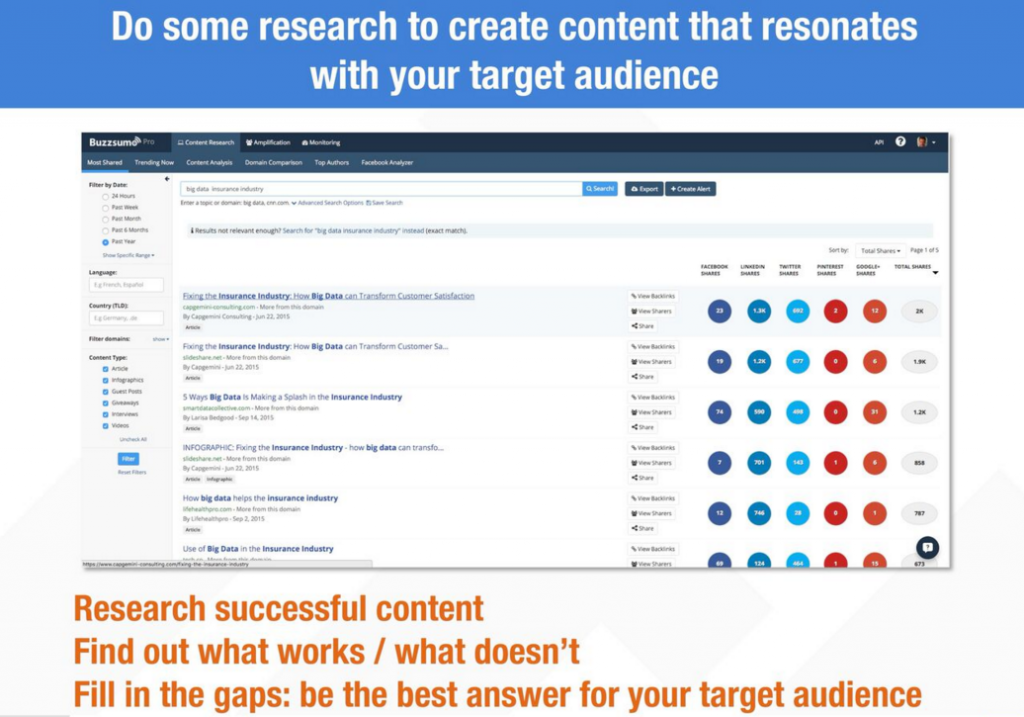
”What content resonates with your audience?”
Steve Rayson – Buzzsumo
To be good, your content needs to be well researched and using a tool like Buzzsumo is a great way to understand what’s been published on a given topic, find out what worked and what didn’t and understand what gaps to fill. You’re not creating content in a vacuum so learn from what already exists.
Leverage content curation to supplement original content
Content curation can be more than sharing third-party content on social channels: don’t just learn from existing content but turn it into curated posts for your blog or weekly or daily round-ups for your email newsletters.
Repurpose content
Content should be like cats: have more than 1 life. When you’ve invested so much in creating great content, think about re-using it over and over by making it into a new format for instance. Here are 15 ways to do that recommended by 5 top marketing experts (as well as what we found out on repurposed content performance).
4. How to maximize the reach of your content
Don’t publish and pray: invest in distributing your content as seriously as you are in creating it. Ultimately, you should aim at doing more than distributing content: you need to promote it and get amplification for it.
Research
Once again, as Steve highlighted, this battle can be won or lost in a good part at the research stage. If you found out what resonates with your audience through good research, your content will have more chances to get shared.
Identify influencers and build relationship with them

This won’t happen overnight but as Steve pointed out, this is one of your best shots at getting significantly more distribution for your content. Buzzsumo conveniently lets you find who shared any post so you can identify influencers likely to be interested in your content. Use the new outreach feature to gather them in lists and start conversations with them. Curating their content is also another great way to get on their radar while also scaling your content as we’ve mentioned above.
Use automation to program your content distribution multiple times
If you’re sharing your content only once, you’re missing out. As Mark Traphagen researched, sharing content multiple times doesn’t fatigue your audience (only a fraction of it is connected when you tweet anyway) but adds several multiples to your content’s traffic. Use software such as Scoop.it Content Director’s social media publishing tools to automate this responsibly: reshare content multiple times, find evergreen content to reshare and make sure you’re not overdoing it by keeping track of your post sharing history in a visual timeline.
Make your team share your content
While making the research mentioned above, Steve realized some companies’ content had less than 8 shares which meant the marketing team didn’t even share its own content! As brands get less organic reach on social networks, it becomes critical to mobilize your co-workers’ natural – and much more authentic – connection with your audience. Here’s a post where we present ways to build your reach through team contribution.
5. How to prove and improve content marketing ROI
By focusing on optimizing your content marketing lifecycle with best practices such as the above ones, you’ll be making great progress on the ROI curve. But how will you measure it?
If you’ve done your strategy as mentioned above, you’ll have planned call-to-actions (CTAs) for the various types of content you’ll publish. And these CTAs will nicely align with your readers’ mindset as they consume your content. So by analyzing your content using the right analytics tools, you’ll be able to have a granular view of each piece of content performance: views, shares and leads.
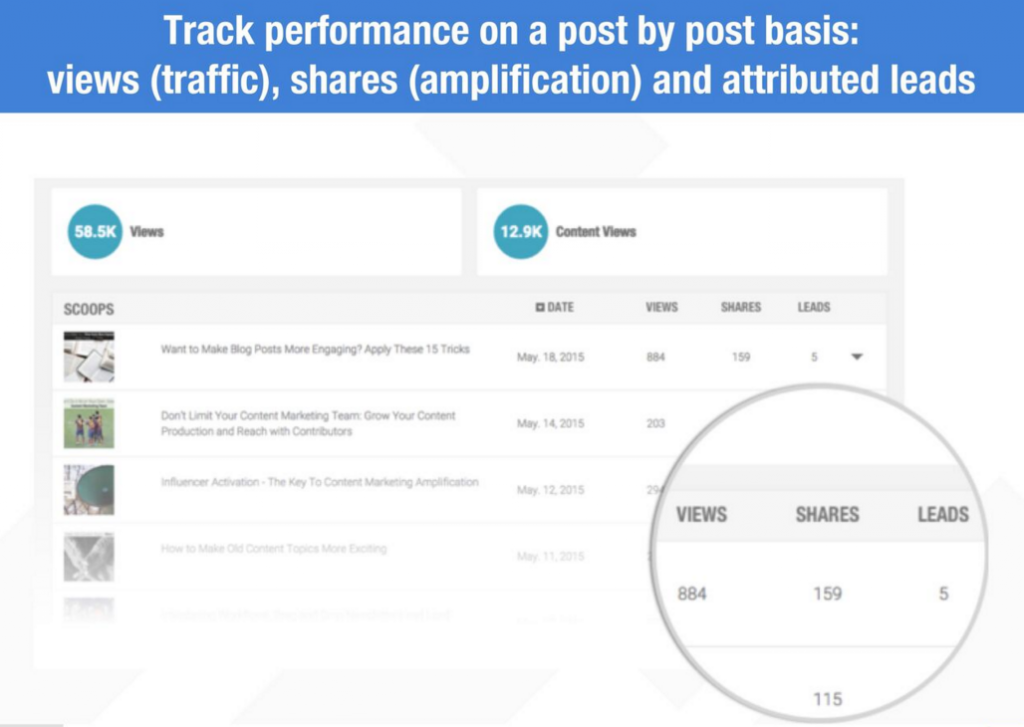
If you’re not sure on how to measure or analyze these KPIs beyond simple pageviews, here’s our guide on how to measure leads your content generates as well as our free content marketing analytics framework.
Content Marketing ROI: questions and answers
To conclude, here’s some answers to the questions we had from participants during the webinar:
“I have a B2B client that is a mid-sized construction firm. We are exploring and growing their reach through content marketing but challenged with “what” to create as the “questions” we might answer are very complex… any ideas where we could find some guidance?” – Kevin.
Who are these questions complex for? If they’re complex for the potential buyers then they’re not the right ones. But if your client’s buyers are technical people that have complex questions that drive their purchase decisions, then they should definitely be addressed no matter how arcane they will sound to an outsider. What you might be struggling with then – and this might be your main question – is how you, as an agency, can come up with expertise in this field to create that content. We hear a lot from marketers – whether in house or agencies’ – that they’re not the subject matter experts for the content they have to create. In this case, we’ve seen a number of strategies to work including:
- Curating content from industry experts and ask company’s subject matter experts to comment / add some insights.
- Encouraging in house experts to contribute by making it easy for them, (for instance interviewing them, doing a write up and asking them to proof-read usually produces better results and takes less of their time than having them write 100%).
- Recruit industry experts as freelance consultants and pay them to contribute to your clients’ blog. Interestingly, our own Julie wrote about her experience doing this with her previous company.
“Would you share the same content on Facebook multiple times? Twitter makes sense, but what about Facebook?” – Ross.
Yes it does make sense on Facebook too. And LinkedIn and Google+. Probably not at the same frequency which optimized one might depend on the type of content: evergreen vs new. But as mentioned during the webinar, I don’t believe there’s a golden rule for the right frequency. Use tools that let you not just share multiple times but that will give you some insight about your sharing timeline and analytics about your performance so you can test, iterate and adjust to find the right frequency.
“I’m sorry, but I fail to understand how you can evaluate leads generated by a blog post… Can you elaborate on this please ? 🙂” – Nina.
By using trackers and analytic tools that will count how many people who read a given blog post ended up converting as a lead later on. There are several ways to perform this attribution and various tools that do that: I did a recap on the pros and cons of Google Analytics, HubSpot and our own Scoop.it Content Director in this post.
“How did you decide to have 3 blog posts a week? How did you get this number?” – Isabelle.
As per the HubSpot study, we’d ideally want to do more but will not sacrifice quality in the process. So we just keep raising the bar as we make progress: we started with 2/month and then targeted a weekly post and so on until we found our current rhythm of 3/week. Don’t think of it as the number that will work for you though: start with something you can reasonably commit to and make it your quarter’s goal to use some of the above best practices to increase that frequency without compromising quality.
“What is the % of success when adding sponsored posts on social media or adwords? Or should it not be used often?” – Wavi.
It’s a great question and I’ll be honest: we’ve mostly failed at doing content promotion ourselves. Not because it’s a bad strategy: I think it’s a great one and I’ve seen some very convincing presentations by Chad Politt’s on that topic. One of the reasons we failed in the past was that we didn’t have a good content marketing analytics system as we now have: being able to track lead generation on a post by post basis as mentioned above. So we plan to experiment with it again and will for sure share the results we have: stay tuned!
“What measurements do you use to measure successful content? conversions, engagement?” – Lauren.
As explained above, we focus on leads, i.e. conversions. Engagement is interesting to understand content performance but it’s not a goal: you don’t get paid in likes, right? 😉 A lot of marketers, me included, have been struggling with this though: can you ask every piece of content to convert? How about top of the funnel content targeting first-time visitors? The ah ha moment for me was when I realized we should make the CTA the adjustment variable: rather than renouncing to use lead generation as an objective for each and every piece of content, we started to change the CTA we used to make it a sensible ask to our readers, given their mindset when reading our content. For instance, we don’t ask first-time visitors reading a piece on how to get started with content marketing to talk to sales: instead, we offer them to sign up to our newsletter or to download an ebook.
“What are best practices for sourcing/attribution for curated content and, in particular, photos?” – Megan.
Very important point from both a legal and an ethical standpoint. There are best practices which mostly consist of providing attribution, backlinks, limiting the amount of content you quote and working with image licenses. We’ve covered them in this post. Also note that following these best practices pretty much on auto-pilot is one of the compelling reasons to use a curation tool (and one of the reasons we built Scoop.it).


